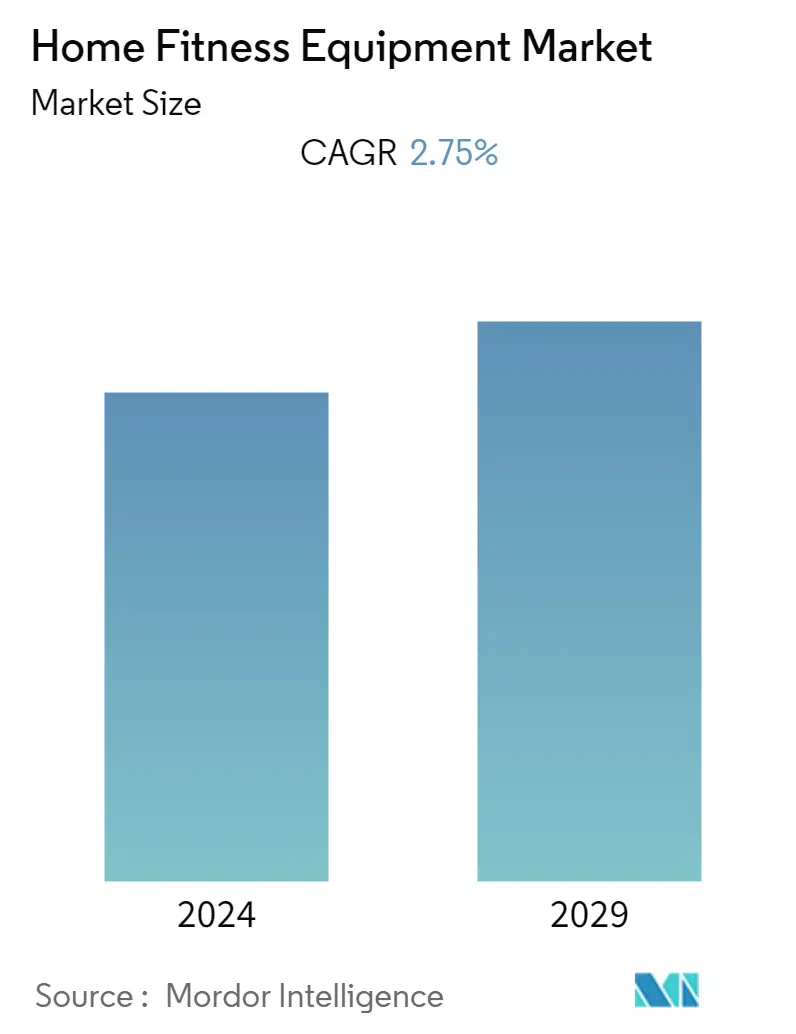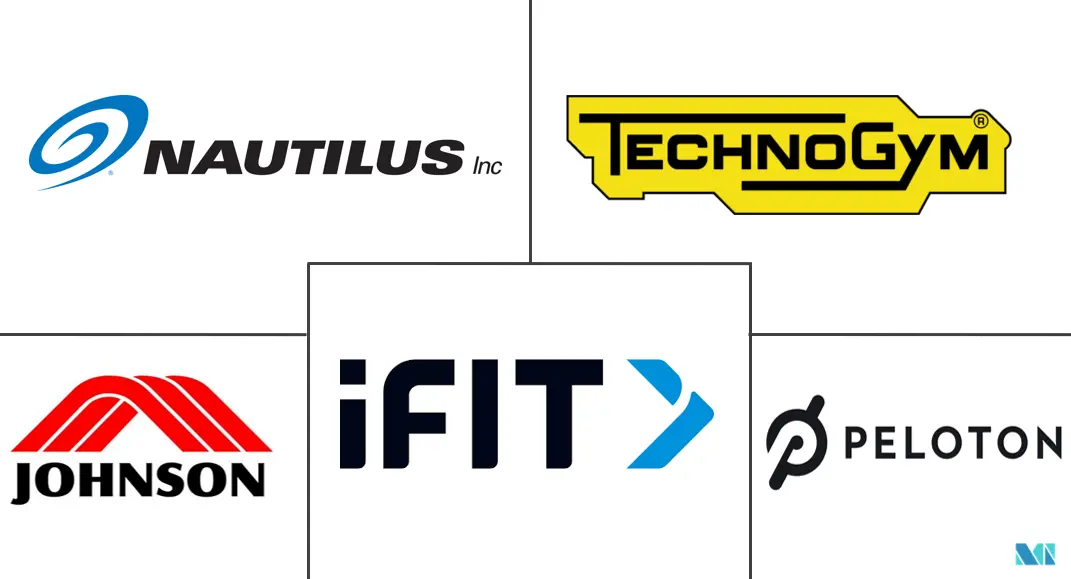Market Size of Home Fitness Equipment Industry

| Study Period | 2018 - 2029 |
| Base Year For Estimation | 2023 |
| CAGR | 2.75 % |
| Fastest Growing Market | Asia Pacific |
| Largest Market | North America |
| Market Concentration | Low |
Major Players
*Disclaimer: Major Players sorted in no particular order |
Home Fitness Equipment Market Analysis
The home fitness equipment market was valued at USD 13,741.23 million in the previous year and is projected to register a CAGR of 2.75% during the forecast period.
Over the short term, precautionary healthcare, coupled with an increasing preference for customized workout regimes (including workout timing) and a comfortable home-friendly environment, is increasing the demand for home fitness equipment as customers are keen to exercise daily. Growth in home fitness equipment in the recent past was also the result of the inconvenience of commuting to a gym to use the machines, trainer fees, and membership fees, primarily in developing countries. The space limitation, primarily for bulk fitness equipment, such as massage chairs, exercise bikes, exercise treadmills, and cross, is a major factor that limits the growth of the home fitness equipment market. This has stimulated start-up gyms, fitness centers, and health clubs worldwide.
Additionally, while not everyone can afford a fully equipped gym, there are various possibilities for small-scale training equipment. As a result, companies like Temple Studio are now offering an all-in-one home gym the size of a mini-fridge, costing just under USD 400. Furthermore, owing to the increasing popularity of smartphones, market players are offering customers the option of managing their services through mobile applications and websites. The e-health platforms are offering video-on-demand, live remote training, creating their own workout programs, and other offers that are self-operated and guided by experts. These associated benefits of e-health platforms have created huge demand among working and busy customers, and it is expected to remain trending in the future. Thus, e-health platforms, gyms, and fitness center consulting services are expected to drive the health and fitness equipment market.
Home Fitness Equipment Industry Segmentation
Home exercise/fitness equipment is any apparatus or device used during physical activity to enhance the strength or conditioning effects on the body. The home fitness equipment market is segmented by product type, distribution channel, and geography. Based on product type, the market is segmented into treadmills, elliptical machines, stationary cycles, rowing machines, strength training equipment, and other product types. Based on the distribution channels, the market is segmented into offline retail stores, online retail stores, and direct selling. The market is also segmented by geography into North America, Europe, Asia-Pacific, South America, and the Middle East and Africa. For each segment, the market sizing and forecasts have been done based on value (in USD million).
| By Product Type | |
| Treadmills | |
| Elliptical Machines | |
| Stationary Cycles | |
| Rowing Machines | |
| Strength Training Equipment | |
| Other Product Types |
| By Distribution Channel | |
| Offline Retail Stores | |
| Online Retail Stores | |
| Direct Selling |
| By Geography | |||||||||
| |||||||||
| |||||||||
| |||||||||
| |||||||||
|
Home Fitness Equipment Market Size Summary
The home fitness equipment market is experiencing a notable shift towards increased demand, driven by a growing preference for personalized workout regimes and the convenience of exercising at home. This trend has been further accelerated by the challenges associated with commuting to gyms, such as travel time and costs, particularly in developing regions. The market is also witnessing innovations in compact and cost-effective fitness solutions, like mini-home gyms, which cater to space limitations in urban settings. The rise of e-health platforms offering digital training options and personalized workout programs has significantly contributed to the market's expansion, appealing to busy consumers seeking flexible fitness solutions. The COVID-19 pandemic has further entrenched these habits, as individuals sought alternatives to traditional gym routines, thereby boosting the adoption of home fitness equipment.
Regionally, North America has seen substantial growth due to heightened health awareness and a focus on preventive healthcare measures. The increasing prevalence of obesity and related health concerns has prompted consumers to invest in home fitness solutions. The competitive landscape of the market is characterized by the presence of both domestic and international players, with major companies like Nautilus Inc., Icon Health & Fitness Inc., and Technogym SpA leading through product innovation and strategic expansions. These companies are leveraging mergers and acquisitions to strengthen their market positions and expand into new regions, such as Africa. The ongoing demand for in-home workout solutions continues to drive the market, as consumers increasingly prioritize health and fitness in their daily lives.
Home Fitness Equipment Market Size - Table of Contents
-
1. MARKET DYNAMICS
-
1.1 Market Drivers
-
1.2 Market Restraints
-
1.3 Porter's Five Forces Analysis
-
1.3.1 Threat of New Entrants
-
1.3.2 Bargaining Power of Buyers/Consumers
-
1.3.3 Bargaining Power of Suppliers
-
1.3.4 Threat of Substitute Products
-
1.3.5 Intensity of Competitive Rivalry
-
-
-
2. MARKET SEGMENTATION
-
2.1 By Product Type
-
2.1.1 Treadmills
-
2.1.2 Elliptical Machines
-
2.1.3 Stationary Cycles
-
2.1.4 Rowing Machines
-
2.1.5 Strength Training Equipment
-
2.1.6 Other Product Types
-
-
2.2 By Distribution Channel
-
2.2.1 Offline Retail Stores
-
2.2.2 Online Retail Stores
-
2.2.3 Direct Selling
-
-
2.3 By Geography
-
2.3.1 North America
-
2.3.1.1 United States
-
2.3.1.2 Canada
-
2.3.1.3 Mexico
-
2.3.1.4 Rest of North America
-
-
2.3.2 Europe
-
2.3.2.1 United Kingdom
-
2.3.2.2 Germany
-
2.3.2.3 Spain
-
2.3.2.4 France
-
2.3.2.5 Italy
-
2.3.2.6 Russia
-
2.3.2.7 Rest of Europe
-
-
2.3.3 Asia-Pacific
-
2.3.3.1 China
-
2.3.3.2 Japan
-
2.3.3.3 India
-
2.3.3.4 Australia
-
2.3.3.5 Rest of Asia-Pacific
-
-
2.3.4 South America
-
2.3.4.1 Brazil
-
2.3.4.2 Argentina
-
2.3.4.3 Rest of South America
-
-
2.3.5 Middle East and Africa
-
2.3.5.1 South Africa
-
2.3.5.2 United Arab Emirates
-
2.3.5.3 Rest of Middle East and Africa
-
-
-
Home Fitness Equipment Market Size FAQs
What is the current Home Fitness Equipment Market size?
The Home Fitness Equipment Market is projected to register a CAGR of 2.75% during the forecast period (2024-2029)
Who are the key players in Home Fitness Equipment Market?
Nautilus Inc., Johnson Health Tech Co. Ltd., Technogym SpA, Peloton Interactive, Inc. and iFIT Health & Fitness Inc are the major companies operating in the Home Fitness Equipment Market.

